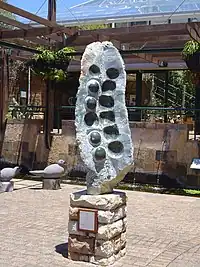
The Chapungu Sculpture Park[1] is a renowned cultural landmark and sculpture garden in Msasa, Harare, Zimbabwe, which displays the work of Zimbabwean stone sculptors. Spanning over 15 acres of landscaped gardens, the park is dedicated to showcasing the rich heritage of African stone sculpture.
History
Chapungu Sculpture Park was established in 1970 by Roy Guthrie as the Gallery Shona Sculpture. Guthrie played a crucial role in promoting the work of Zimbabwean sculptors on an international scale. His efforts led to many exhibitions, including a touring exhibition titled "Chapungu: Custom and Legend — A Culture in Stone," which showcased the sculptures in various botanical gardens worldwide.
The places visited include:
- (1999) Kirstenbosch National Botanical Garden, Cape Town, South Africa
- (2000) Royal Botanical Gardens, Kew,[2] London, United Kingdom,
- (2001) Missouri Botanical Garden, St Louis, USA
- (2001) Boyce Thompson Arboretum State Park, Superior, USA
- (2002) Red Butte Garden and Arboretum, Salt Lake City, USA
- (2003) Garfield Park Conservatory, Chicago, USA
- (2003) Chicago Botanic Garden, Chicago USA
- (2004) Denver Botanic Gardens, Denver, USA
Collection
The sculptures in Harare encompass the largest collection from the First Generation (those who created between the late 1960s and the 1980s) to the present day, featuring the creations of renowned sculptors such as Joram Mariga, Joseph Ndandarika, Henry Munyaradzi, Nicholas Mukomberanwa, Sylvester Mubayi, Bernard Matemera, Richard Mteki, John, Bernard and Lazarus Takawira and Brighton Sango, as well as many from the Second Generation (those who created between the 1980s and 1990s) such as Tapfuma Gutsa, Agnes Nyanhongo, Colleen Madamombe, Rachel Ndandarika, Dominic Benhura, Joe Mutasa, Arthur Fata, Jonathan Gutsa, Fabian Madamombe, Taylor Nkomo and Eddie Masaya. These masterpieces, crafted from Zimbabwe's diverse range of stones, embody the country's deep connection to the natural world, spirituality, and ancestral heritage. Chapungu is committed to showcasing authentic sculptures by these renowned sculptors at its outdoor museum specifically dedicated to the early sculptors, including the early artists from the Tengenenge Community. There, many schools and art collectors learn about the artwork that emerged from this period, most of which are very organic as they were carved using hand tools with no machinery.
For those seeking a more intimate encounter with contemporary Zimbabwean art, the park's indoor gallery houses an impressive array of sculptures crafted from semi-precious stones like rose quartz, verdite, aventurine, red jasper, and agate. These intricate pieces showcase the ingenuity and artistic vision of Zimbabwe's modern sculptors.
Features
Chapungu Sculpture Park is characterised by its tranquil ambiance and offers visitors a serene escape from the hustle and bustle of everyday life. The main entrance features a beautiful cathedral of over fifty Fever Trees, creating an enchanting gateway into the park. Within the park, visitors can explore the meticulously landscaped gardens that boast over 100 species of indigenous trees and shrubs, providing a picturesque backdrop for the stone sculptures.
The park is home to a diverse collection of life-size stone sculptures, each with its own unique story and cultural significance. These sculptures offer a glimpse into the rich heritage of Africa and celebrate the talent and creativity of Zimbabwean sculptors.
Artists
Among the artists whose works can be seen at the park are:
- Dominic Benhura
- Crispen Chakanyuka
- Square Chikwanda
- Sanwell Chirume
- Stanford Derere
- Arthur Fata
- Barankinya Gotsa
- Tapfuma Gutsa
- Chrispen June
- Makina Kameya
- Biggie Kapeta
- Royal Katiyo
- Samson Kuvengura
- Derek Macheka
- Colleen Madamombe
- Fabian Madamombe
- Wazi Maicolo
- Amali Mailolo
- Damian Manhuwa
- Josia Manzi
- Joram Mariga
- Eddie Masaya
- Moses Masaya
- Passmore Mashaya
- Bernard Matemera
- Boira Mteki
- Bryn Mteki
- Richard Mteki
- Sylvester Mubayi
- Thomas Mukarobgwa
- Nicholas Mukomberanwa
- Joseph Muli
- Henry Munyaradzi
- Joe Mutasa
- Tendai Mutasa
- Joseph Muzondo
- Joseph Ndandarika
- Locardia Ndandarika
- Agnes Nyanhongo
- Euwit Nyanhongo
- Gedion Nyanhongo
- Brighton Sango
- Amos Supuni
- Bernard Takawira
- John Takawira
- Lazarus Takawira
Chapungu Sculpture Center
The park also houses the Chapungu Sculpture Centre, which hosts an important residency program and plays a crucial role in shaping the careers of young sculptors. The center offers a residency program that provides emerging artists with the opportunity to work alongside established sculptors and learn from their expertise. Additionally, the HAYA Cooperative, a group of artists who work at Chapungu, actively contributes to the artistic community at the park.
Expansion
In 2007, Chapungu Sculpture Park expanded to Loveland, Colorado, with the establishment of another park and gallery. This expansion has allowed a wider audience to experience the unique beauty and cultural significance of Zimbabwean stone sculptures.
Events
Chapungu Sculpture Park is not only a place of artistic appreciation but also a popular venue for various events. With its idyllic setting and serene environment, the park provides a picturesque location for corporate events, weddings, and other special gatherings.
Conclusion
Chapungu Sculpture Park stands as a testimony to Zimbabwe's artistic legacy and the rich creativity of African culture. Through its collection of stone sculptures and its commitment to supporting emerging artists, the park showcases the depth and beauty of Zimbabwean art. Its expansion to Loveland, Colorado speaks to its global recognition and continued impact on the art world. Cherished by locals and appreciated by visitors worldwide, Chapungu Sculpture Park serves as a captivating celebration of Zimbabwe's artistic heritage.
See also